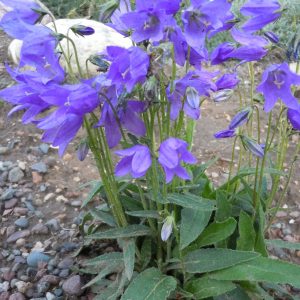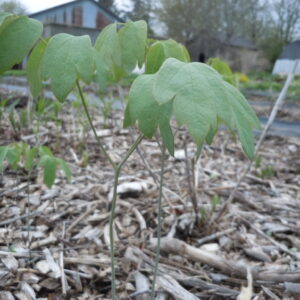Archives
Showing 25–32 of 164 results
-
Camassia quamash Wild Hyacinth, Leichtlin’s Camass Z 4-8
Mid-spring spikes of 2” pale blue star-shaped flowers rise over grass-like foliage
ARCHIVED
Note: This is a plant not currently for sale. This is an archive page preserved for informational use.
Mid-spring spikes of 2” pale blue star-shaped flowers rise over grass-like foliage
Size: 15” x 12"
Care: sun to part shade in moist, well-drained soil
Native: Pacific Northwest
Wildlife Value: Attracts butterflies and hummingbirds. Deer & rabbit resistantFirst documented by Lewis & Clark near the Nez Perce village in the Cascade Mountains. Nez Perce hunters gave Clark a cake made with Camassia. Important food crop for First Americans. Recommended by Gertrude Jekyll 1908.
-
Campanula collina Dark blue bellflower Z. 5-8
In summer dark blue-purple bells on upright stems on clumps of this bellflower.
ARCHIVED
Note: This is a plant not currently for sale. This is an archive page preserved for informational use.
In summer dark blue-purple bells on upright stems on clumps of this bellflower.
Size: 6-12” x 8”
Care: sun to part shade in well-drained to moist well-drained
Native: western Asia, Turkey, Caucasus MountainsCampanula is Latin meaning “little bell.” Collina means “on hills.” Collected before 1826.
-
Campanula punctata var. rubriflora Z 4-9
Dangling rosy purple bells hide their red spots inside the petals
ARCHIVED
Note: This is a plant not currently for sale. This is an archive page preserved for informational use.
Dangling rosy purple bells hide their red spots inside the petals – early summer
Size: 12”x16” & spreading
Care: Sun to part shade in moist well-drained soil
Native: Japan
Awards: Top rated for ornamental traits and landscape performance by the Chicago Botanic Garden.Campanula is Latin meaning little bell. Punctata means spotted. In 1629 Parkinson described campanulas as “cherished for the beautie of their flowers.” This variety collected in Japan before 1950.
-
Caragana rosea Pink peashrub Z 3-8
Rose-pink , pea like flowers May-June on prior years wood. Flowers give way to slender yellowish-green seed pods that mature to brown in late summer. Yellowish fall color.
ARCHIVED
Note: This is a plant not currently for sale. This is an archive page preserved for informational use.
Rose-pink , pea like flowers May-June on prior years wood. Flowers give way to slender yellowish-green seed pods that mature to brown in late summer. Yellowish fall color.
Size: 3-4’ x 3-4’
Care: full sun to light shade in dry to medium, well-drained soil. Perfom well in areas with hot summers and cold winters.
Native: Slopes and valleys in central and NE China, Japan and Russia
Wildlife Value: Attracts bees, butterflies and hummingbirds. Deer resistantPlants are considered to be xerophilous (capable of thriving in dry, hot locations). Described by Nicolai Stepanowitsch Turczaninow in Primitiae Florae Amurensis 470. 1859
-
Carex davalliana Bath’s sedge, Davall’s sedge Z 4-8
Short hedge-hog like clump with white flowers
ARCHIVED
Note: This is a plant not currently for sale. This is an archive page preserved for informational use.
Short hedge-hog like clump with white flowers turning to bronzy spiked seedheads May-June. Best for rock, railroad or fairy gardens – anyplace for a miniature, clumping grass.
Size: 6” x 12”
Care: sun to light shade in moist soil
Native: wet places in Europe and western No. AmericaCollected before 1798 by Edmund Davall who botanized in Switzerland.
-
Carex montana Soft-leaved Sedge Z 4-10
Soft mounding grass with small brown flower spikes March-April
ARCHIVED
Note: This is a plant not currently for sale. This is an archive page preserved for informational use.
Soft mounding grass with small brown flower spikes March-April
Size: 10” X 10”
Care: Part sun to shade in well-drained soil
Native: Europe, Caucasas, West SiberiaLinnaeus 1753
-
Catanache caerulea Cupid’s dart Z 4-8
July – September violet cornflower-like flowers with rectangular petals fringed at the ends with deep purple centers.
ARCHIVED
Note: This is a plant not currently for sale. This is an archive page preserved for informational use.
July – September violet cornflower-like flowers with rectangular petals fringed at the ends with deep purple centers.
Size: 16-18” x 8-12”
Care: sun in moist well-drained soil
Native: MediterraneanAn aphrodisiac in ancient Greece. The genus name is adapted from the Greek name for this plant, Katananke which means “forced down against choice” or “compulsion,” as it was believed to be the date rape drug of its day. It is called Cupid’s dart even now because Greeks & Romans used the plant into food of an object of affection. However, it has no actual effect, except perhaps belief in a myth.
-
Caulophyllum thalictroides Blue cohosh Z 3-8
Glaucous blue-green leaves can be mistaken for meadowrue. Inconspicuous yellow flowers from April-May followed by blue-berried seeds in fall.
ARCHIVED
Note: This is a plant not currently for sale. This is an archive page preserved for informational use.
Glaucous blue-green leaves can be mistaken for meadowrue. Inconspicuous yellow flowers from April-May followed by blue-berried seeds in fall.
Size: 1-3’ x 1’ slow spreading to form colonies
Care: shade in moist well-drained soil, deer and rabbit resistant
Native: Eastern and Central North America, WI Native
Wildlife Value: attracts bees and moths, mice and birds eat the berriesCollected by Michaux c. 1800.




